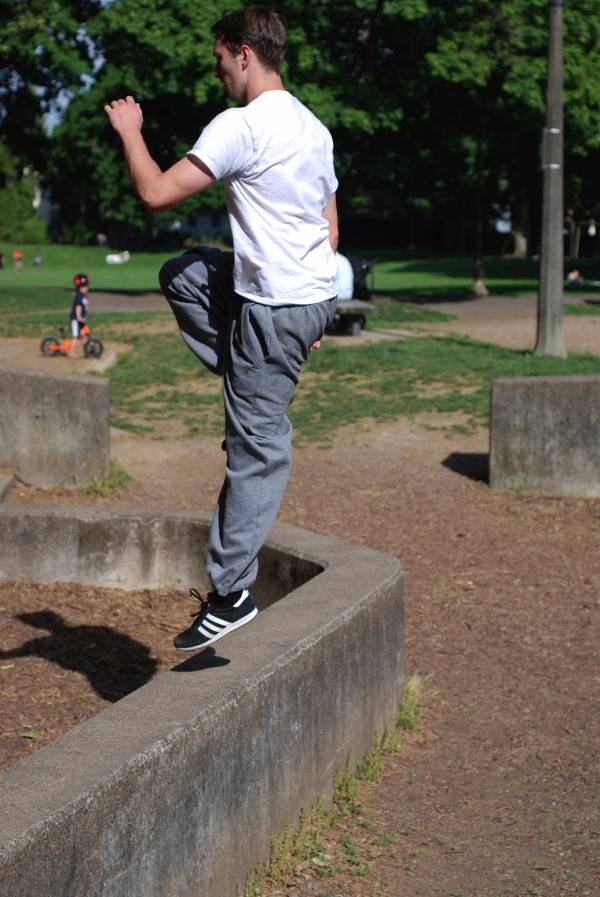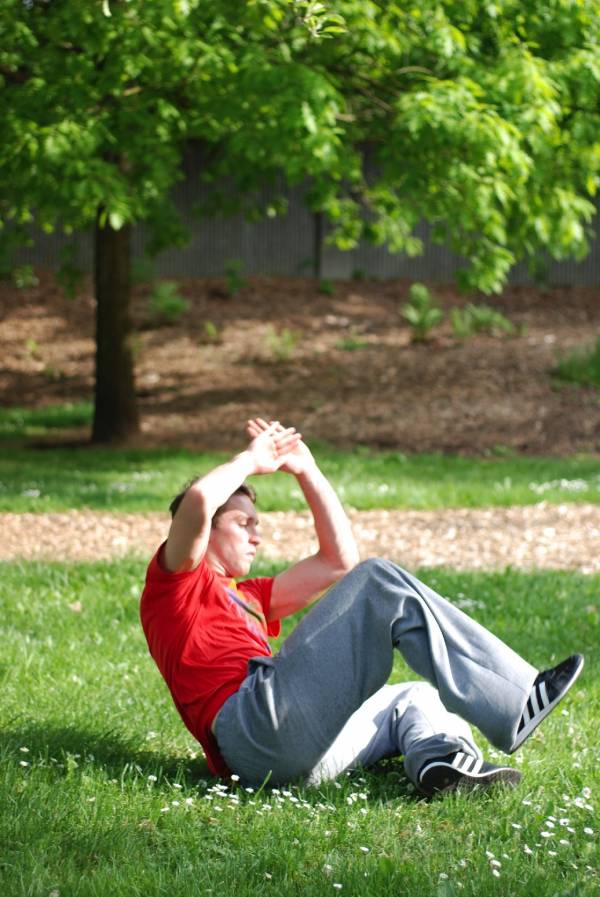Last year a well-known Russian freerunner, Pavel Kashin, performed a backflip while standing on the edge of a sixteen-storybuilding. The movement was well within his skill set, but the risk he chose to take was enormous. Upon landing he slipped from the edge of and fell to his death.
I was reminded of his death upon hearing the tragic news that CrossFit athlete Kevin Ogar suffered a spinal cord injury in a competition a few weeks ago. Anderson Silva’s gruesome tibia fracture during a UFC fight is another recent example of an athlete getting injured in action. Everywhere you turn you are confronted with news of another athlete’s tragic experience. Injuries within elite athletics aren’t necessarily inevitable, but they are way more likely to happen when you consider the escalation of risk that is so popular nowadays. Big air. Balls-out-intensity. Immense fatigue. Many factors contribute to the danger that is encountered within high-level sports.
Does that mean that you, an amateur athlete, are at the same risk for catastrophic injury when performing similar events? No. Not if you’re in it for the simple joy of movement and are smart in your training. By definition, professional athletes are paid to take on immense risks. They challenge their bodies at levels that you and I simply don’t need to entertain.
Take parkour as an example. When I tell people that I do parkour, it’s common for their eyes to go wide and for them to utter that they’d never leap between buildings or flip from rooftops. Guess what? Neither do I. I stay low to the ground and train well within my safety zone, challenging myself only when I’ve weighed the risk versus reward.
Yet, many people’s first impression of parkour is what they have seen on YouTube: advanced practitioners pushing the limits of the sport. To say that when you or I train parkour is to prepare ourselves for the same antics of those athletes, would be like saying that anyone who has taken a karate class has the end goal of competing in a five-round MMA fight. That’s obviously not the case. When you do a sport it doesn’t have to culminate in the most risky situation imaginable. Your decision to participate in any sport can be for fitness, entertainment, or just to be a more complete human.
That said, injuries do happen to us non-professional athletes. Heck, they even happen us when we’re not doing anything athletic at all. Even after thirteen years as a physical therapist, I’m always surprised when someone tells me how he or she broke an ankle doing something silly, like stepping off a curb. Accidents happen, but that doesn’t mean you shouldn’t take steps to prevent them.
These seven reminders will help you reduce your risk of injury in parkour or any other athletic activity:
 Warm up: Before attempting any rigorous athletic activity it’s crucial that you get your body ready for motion. Your warm up should loosen your joints, awaken your nervous system, heighten your awareness, and prepare your muscles for quick action. Shoot for ten minutes of bodyweight activity to elevate your heart rate and initiate a light sweat.
Warm up: Before attempting any rigorous athletic activity it’s crucial that you get your body ready for motion. Your warm up should loosen your joints, awaken your nervous system, heighten your awareness, and prepare your muscles for quick action. Shoot for ten minutes of bodyweight activity to elevate your heart rate and initiate a light sweat.- Take lessons from qualified teachers: Let other people’s hard-won knowledge keep you from getting hurt. Someone who has traveled the beginner’s path before you can give you pointers about how to execute movements effectively and with less risk of injury.
- Scale your movements appropriately: Understand there is an infinite number of mini-steps you can take to build up to a risky movement. For example, before you try balancing on a railing, practice with precision trainers on the ground. Don’t try to jump ahead of your skill level.
- Know when to call it quits: There is a common story in snow sports like downhill skiing and snowboarding, that it is often the last run of an afternoon when someone gets hurt. Your nervous system is exhausted, your muscles are worn out, and you’re just not as mentally sharp as earlier in the day. If you’ve been training for a few hours and fatigue is starting to creep in, it’s best not to attempt a skill that has a high degree of difficulty. Save the big tricks for when you are fresh.
- Understand how people get injured: You should try to understand the common ways that people get injured in parkour or whatever sport you are doing. Athletic activities have common patterns of injuries based on the movements that are unique to them. I did a small survey of parkour athletes in 2012 and found the vast majority of injuries were traumatic in nature and affected the joints of the lower body.
 Practice “bails” and escapes: Part of your day-to-day training should drill how to fall safely and how to get out of a movement that has gone bad. Amos Rendao of APEX Movement has a dedicated YouTube channel about safe falling techniques, called Parkour Ukemi. Subscribe and learn.
Practice “bails” and escapes: Part of your day-to-day training should drill how to fall safely and how to get out of a movement that has gone bad. Amos Rendao of APEX Movement has a dedicated YouTube channel about safe falling techniques, called Parkour Ukemi. Subscribe and learn.- Be aware of the environment: Trail runners use the term terrain surveillance, to describe how they look at a trail to keep from rolling an ankle or slipping in the mud. When you are outside training parkour, make it a habit to look for things in the environment that could impact your safety. Is the concrete damp? How stable are the obstacles? By scoping out the environment you can anticipate how things might go bad, influencing your risk of injury.
Photos courtesy of Ben Musholt.






